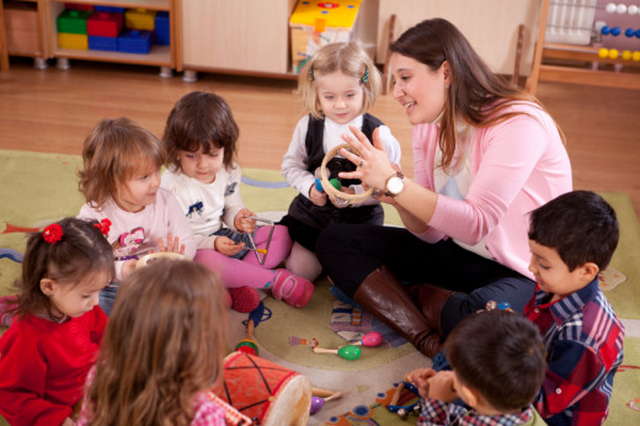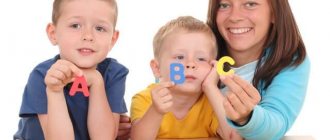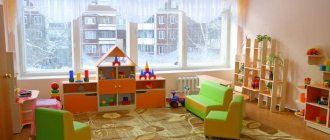The topic of child adaptation in kindergarten is always relevant, but in recent years it has become increasingly acute. The pace of modern life dictates its own rules, and parents do not want to lag behind it, so from an early age they send their child to kindergarten, where they are faced with difficulties in getting the child accustomed to new conditions and do not understand how to resolve them correctly.
Development and education of children from 2 to 11 years old in a playful way

Start practicing right now
Start practicing
In this article we will look at what a child’s adaptation to preschool is, what degrees and stages of adaptation exist, and how to help a child successfully overcome this difficult period.
What is adaptation
The term adaptation (lat. adaptatio) means “adaptation”. When they talk about a child’s adaptation in kindergarten, they mean his adaptation to new conditions - the people around him, the daily routine, new rules, the absence of parents. From this moment the active socialization of the child begins, which may be accompanied by some difficulties.
During the adaptation period, emotional and physical instability can be observed - the child may cry often, miss his mother, get upset over little things, stop eating or sleeping. This is fine.
Tips for the teacher: how to facilitate the adaptation process
The teacher plays an important role in the child’s adaptation process. The quality of his interaction with the child and with the parents affects how the whole process will go overall and how quickly it will end.
Teacher's work with parents
For adaptation to be painless, the teacher first needs to establish contact with the parents.
- Invite parents on a tour of the daycare before they bring their child there. Let them see where their children will sleep, play, eat and study. Familiarize them with the daily routine. Parents' peace of mind is the key to a child's positive attitude towards kindergarten. Any anxiety of parents will be transmitted to children.
- When your child is in a group, create a chat for the parents of this group in any popular instant messenger, such as Whatsapp or Telegram. Keep active and dialogue in this chat - answer questions, publish news and announcements. Such a chat will give parents a sense of control and peace of mind, because they will be able to get information about their child at any time.
- Agree with parents to bring their children to kindergarten 5-10 minutes apart. This will allow you to meet each child individually and establish contact with them so that the process of parting with parents is more painless.
You can print and distribute to parents the Kindergarten Adjustment Guide developed by our experts. .
Once contact with parents is established, relationships with children can be built.
Teacher's work with children
It is important to establish a trusting relationship with your children so that they feel safe around you.
- When you first meet your baby, be gentle with him. Show sincere kindness, smile, offer your help, show interest in him, for example, ask questions about his mood and well-being. From the first meeting, the child should get the impression that you can be trusted, that you are a friend who will always help.
- Get to know your child in an informal setting. For example, join your baby and mom for a walk. Then the child will perceive you as an acquaintance when he sees you in kindergarten.
- Create a warm and homely atmosphere in the group so that children feel comfortable and safe. This can be done with the help of decorative items - indoor flowers, small houses or corners for privacy. Children can bring their own toys so that familiar objects are nearby.
- Touch and hug children periodically. Tactile contact gives them a feeling of security and helps them adapt faster.
- Many children want their mother to be nearby. You can satisfy this need in kindergarten by creating a “family” album. Place it in free access so that the child can come up and look at a photo of mom or dad at any time.
- Involve children in group and individual interesting games. If children are carried away, their worries will fade into the background. In addition, games will help to form in the teacher the image of a leader who will come to the rescue in any situation.
What not to do when separating from a child
There is a list of recommendations that every adult should follow when taking a child to a preschool institution:
- A phrase like: “If you don’t listen to me, I’ll take you to kindergarten!” - it's taboo! After all, what is used to scare cannot evoke positive emotions.
- If the baby cries when parting, do not scold him or get angry. The best helper here is patience, attention, kind words and actions (hug, kiss, don’t forget to say that you will definitely take it).
- Don't promise the impossible. For example, today you go, and tomorrow you stay at home. And, if you promised, be sure to keep your word.
- Try not to be the last one to pick up your baby. Especially in the first months of his stay in the garden.
- Instead of the listed “don’ts,” praise more often, listen carefully and with interest to his stories about life in the team, about his achievements and failures.
Algorithm for adaptation to kindergarten
Adapting a child to kindergarten is a step-by-step process. The teacher’s task is to regulate these stages and guide parents.
It is better to start visiting kindergarten with daytime and evening walks with a group. The mother stays next to the child during these walks. During the first week, you can bring your child for a few morning hours. If possible, the mother stays in the group with the child; if not, then she simply comes to pick him up after a morning walk.
During the second week, the baby's stay increases until lunchtime. He eats with the others, after which his mother takes him home. In the third and fourth weeks, the baby can be left for a nap and picked up immediately after sleep or after an afternoon snack.
After the fourth week, the child can be left in kindergarten full time. During the adaptation period, it is important to bring the child in first or last so that he does not see the tears of other children. It is better to feed the child at home, since many children refuse to eat in an unfamiliar environment, especially unusual food.
Consultation for teachers “Psychological and pedagogical conditions for adaptation of children in preschool educational institutions”

can be distinguished according to the nature of adaptation to new living conditions .
The first group are those for whom the adaptation process is easy and painless. They show interest in toys and activities, are sociable, independent, and balanced. Communication between parents and child is friendly and respectful.
The second group are children who adapt more slowly and more difficultly. Periods of interest in the game are replaced by periods of indifference and whims. There is a lack of trust in relationships with teachers and other children. Playing and communication skills are underdeveloped. Low initiative. Less independent, they can do something themselves, but mostly depend on an adult. On the part of parents, there is instability in communication: friendly, reasonable appeals are replaced by shouts, threats or weakening demands, inattention.
The third group is children who have difficulty adapting to their new life. As a rule, they are not independent, non-contact. Accustomed to instability in the daily routine. They get tired quickly. Gaming skills are not developed. The experience of such children is a manifestation of authoritarianism, cruelty, or, conversely, excessive liberalism on the part of adults, which causes fear, distrust of the teacher, or complete ignorance of him and other children. Sleep and appetite are poor or completely absent. High morbidity further slows down adaptation to the new environment and new requirements.
The process of adaptation of a child to the conditions of a kindergarten, in addition to a certain duration in time, different for different children, has several main stages (phases). These are, in particular, the following stages:
1. “Storm” - in response to a complex of new influences, all systems of the child’s body respond with a violent reaction and significant tension. Increased excitability, anxiety, possible increase in aggressiveness or withdrawal. Poor sleep, appetite, mood. The physiological and psychological storm lasts from 2-3 days to 1-2 months (in some children).
2. “The storm subsides” - a period of unstable adaptation, when the child’s body is looking for optimal options for reacting to external influences. The baby continues to look closely at the new environment, tries to participate in joint activities, becomes more active, interested, and balanced. This period is longer than the first - from 1 week to 2-3 months.
3. “Calm” is a period of relatively stable adaptation. The body finds the most favorable options for responding to new living conditions, daily routine, and communication. The child begins to actively assimilate new information, establish contacts, and take real part in classes. The incidence of illness decreases, sleep, appetite, and mood are stabilized. This period lasts from 2-3 weeks to six months.
Therefore, the kindergarten teacher and psychologist must help the child adapt to new conditions. In our opinion, a mandatory rule when adopting a child should be a visit to a psychologist’s office. This visit is still needed during the paperwork process.
An attentive, observant psychologist will make certain conclusions during a conversation regarding the child’s preparedness for staying in a preschool institution and the style of upbringing in the family. He will begin by identifying some of the newcomer's individual characteristics in order to select a group that will best suit his habits, behavioral characteristics, and temperament. It is important to give specific recommendations to parents on how they should prepare their child for a new life.
Indicative questions for a conversation between a psychologist and parents
(after receiving general information about first name, last name, age, health status, etc.):
Does the child have experience interacting with other children?
What is the nature of this communication?
What games does your son (daughter) like to play?
What exactly influences a child's behavior the most? (Communication style, place, mode, environment, health, etc.).
What mood prevails during the day?
What are you interested in? What types of activities do you like most?
How does a child’s physical development occur? Are you tempering it? How?
How do you see your son (daughter): balanced; excessively mobile, fast, noisy; slow, sluggish?
What education system do you adhere to: authoritarian; democratic; liberal?
Is there consistency in parenting among family members? Who else is involved in education?
Does the child have brothers and sisters? How does she communicate with them?
Do you try to keep a daily routine at home? Does it coincide with the kindergarten regime?
How does your baby fall asleep? Sound asleep? What is his appetite?
Is the child independent for his age? What can he do on his own?
Is your son (daughter) obedient? If you don’t listen, how do you react: you get offended; scold; punish; not paying attention, etc.?
How do you react to your child’s complaints about quarrels with other children: defend, blame; brush it off; are you trying to figure it out, etc.?
If you understand that you were wrong, do you ask your son (daughter) for forgiveness?
What does your child like most?
What worries you about your child’s behavior and development?
What do you think a teacher should be like?
When conducting an introductory conversation with parents, you should take into account not only the content of what the parents say, but also the intonation, facial expression and especially the child’s behavior. In particular, the following points require attention:
how the child behaves in the presence of unfamiliar adults (timidly, confidently, interestedly, indifferently, impudently);
general style of behavior (calm, balanced, inert, overly energetic);
interest in the environment, toys, games (asks to play, looks with interest, plays if offered, plays himself);
the nature of the mother’s communication with the child (speaks kindly, politely, with respect, with exclamations, irritably, with threats);
how the child reacts to the mother’s appeals and requests (listens, is capricious, ignores).
According to the information received, the group in which the baby will be located is determined. This problem is aggravated if there are several groups of children of the same age in the kindergarten (two older, three middle, etc.) or if there are groups of different ages. In this case, one should take into account the quantitative and qualitative composition of the children in the group (for example, take into account the characteristics of higher nervous activity). It is impossible not to take into account the teacher’s style of behavior, his manner of communicating with children: it is advisable that it coincides with the mother’s manner of behavior, which is familiar to the child.
The first day of your child’s stay in kindergarten should be limited to getting to know the teacher, the children, and the group room. In the following days, the teacher and psychologist carefully monitor his behavior in the group and provide additional advice to parents.
The purposefulness of observations and the objectivity of conclusions will be facilitated by the use of behavioral control tests for novice children .
1. Child’s mood (cheerful, calm, irritated, depressed, unstable):
cheerful - has a positive attitude towards the environment, reactions are emotionally charged, often smiles, laughs; willingly communicates with others;
calm - has a positive attitude towards others, responds to initiative, but does not show it himself, positive emotions are manifested to a lesser extent;
irritated, excited - there are affective outbursts of excitement, whims, crying, conflicts often arise with others;
depressed - lethargy, inaction, passivity, isolation, sadness, quiet and prolonged crying are observed;
unstable - quickly moves from one mood to another, can be cheerful, laugh and immediately cry, often conflicts, can be withdrawn.
2. Sleep (falling asleep, sleep pattern, duration):
falling asleep - fast, slow (more than 10-15 minutes), calm, restless, with additional influences; nature of sleep - deep, shallow, calm, restless; Duration of sleep - short, long, in accordance with age.
3. Appetite: good, bad, selective attitude towards food.
4. Behavior while awake (active, inactive, passive):
active - the child is busy with activities;
inactive - not always busy, active activity is replaced by periods of inactivity;
passive - inaction predominates.
5. Communication skills (high, medium, low):
high - the child takes proactive actions with adults and other children, resolves conflict situations fairly, independently, if necessary, turns to adults for help, and can correctly assess his behavior;
average - he does not show initiative, but responds to proactive actions on the part of others, in case of conflict, turns to adults for help, correctly evaluates his behavior;
low - does not respond to proactive actions and does not show initiative, reacts to conflicts with tears, screaming, cannot evaluate the behavior of oneself and others.
The findings of observations regarding the level of development of the child’s speech (according to age) are also summarized: high; average; short; by level of development of self-care skills (according to age): high, medium, low; by level of development of gaming skills (according to age): high; average; short; regarding individual characteristics of behavior: goodwill - aggressiveness; initiative - passivity; slowness - mobility; interest in games, activities - indifference; contact - isolation, etc.
The results of the child’s examination are recorded in the adaptation diary.
Recording scheme (vertical columns): serial number; observation date; last name, first name, age; mood; dream; appetite; behavior while awake; communication skills; level of development of self-service skills; level of development of gaming skills; level of speech development; individual behavioral characteristics; recommendations for parents; educators.
psychological and pedagogical conditions for ensuring the process of adaptation of children to attending kindergarten can serve as a kind of informative attraction for educators and psychologists :
1. Gradual development in the child of the habit of observing a certain daily routine. It is best to do this at home before starting kindergarten. In the garden - providing a flexible regime.
2. Formation of self-service skills (the ability to eat, dress independently, fold toys, clothes, etc.).
3. Development of gaming skills and communication skills. Gradual expansion of the baby’s circle of acquaintances.
4. Organization of positive emotional communication between the child and the teacher and kindergarten staff.
5. The equipment of the group room should provide for the possibility of individual games, activities, and satisfy the child’s desire to be alone or alone with the teacher.
6. Ensuring inter-age communication between children as one of the most effective conditions for successful adaptation to a new way of life.
7. Ensuring meaningful activities for preschoolers, taking into account the individual interests of each child and his age capabilities.
8. Psychological and pedagogical education of parents on issues of facilitating adaptation to kindergarten (individual conversations, consultations).
9. Gradual increase in the duration of the child’s stay in kindergarten (at first - only a walk, play, then - a walk, lunch, after a few days - a walk, lunch, sleep, etc.).
10. Expanding the circle of close people who bring the child to kindergarten (not only mom, but also dad, sister, grandfather - this makes saying goodbye easier).
11. Conducting special game complexes aimed at expanding the circle of friends, developing confidence, relieving anxiety and fears.
Thanks to the provision of these and other conditions, sleep and appetite are quickly restored to newbie children. True, the process of normalizing the emotional sphere of a child can be lengthy, which should become the subject of special care of a psychologist, educators, and parents. Adequate behavior, interest in communicating with adults and children, active participation in activities and games, cheerful mood are the main indicators of a child’s socio-psychological adaptation to the conditions of kindergarten.








